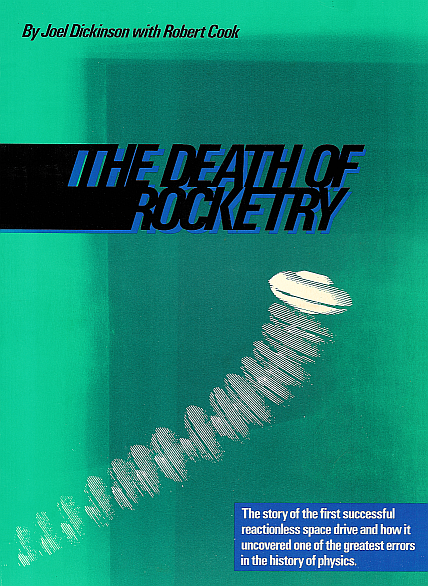Previously I have pointed out that the only force exerted on the mass-projectile in a centrifugal gun, Fc, and the reaction force exerted on its rotor, Fr, are always both perpendicular to the mass's direction of motion. However, any force bringing the mass to rest must of course be exerted along its direction of motion. This raises the question:— if the rotor is otherwise unconstrained while it rotates, is Newton's third law still obeyed overall between the mass and the rotor?
Back in the early 1980s, I decided to look into this in some detail.
 |
| Coriolis force vectors exerted on a rotor expelling a mass |
The image above shows the Coriolis force reaction vectors (blue) being exerted on an anti-clockwise turning rotor, when a mass enters it, and is accelerated through a radial tube in the rotor. The first question of interest is: when added, do the Coriolis force vectors give a resultant that has a direction exactly opposite to that followed by the expelled mass?
To put this another way: when the mass has been expelled, is it travelling in a direction exactly opposite to that of the rotor? Furthermore, is there an exact balance between i) the force through distance required to slow the mass down and reverse its direction for the next operating cycle, and ii) the force through distance required to bring the rotor to rest? Unless both of these conditions are met, an inertial propulsion machine must be possible. (Recall that Newton's third law requires an equal and opposite reaction force).
Was I first?
Before attempting any answers, I should mention that although I once thought I was first to see this possibility, I don't think so now.
 |
| The Death of Rocketry |
However, I found these inventions less interesting than another idea discussed and illustrated in the book, as shown, which is essentially the same as mine, and was probably thought of earlier:—
 |
| The Death of Rocketry, Fig. 6-14, p85 |
The comment on this idea (by co-author Joel Dickinson) ends:—
"The principle looked sound, but to construct a model would be nightmarish. To Cook, destroying all this energy by collision seemed a crime, so we abandoned these ideas."
I am not at all convinced that the kinetic energy imparted to the masses must necessarily be "destroyed". I think it would only require a bit of engineering (not especially difficult) to recover this energy.
Silux models, and further work
When I had become proficient with silux, I made a few models of this "inertial propulsion by Coriolis force" idea. As far as the questions I posed above are concerned, I can only say at present:—
- None of my models have shown any deviation from an exact 180º angle between the direction travelled by the mass and that travelled by the rotor, after the mass has been expelled from the rotor. So my modelling so far does not indicate any possibility of inertial propulsion.
- However, I have done nothing more than a few spot-checks, only on rotors with radial tubes, turning at constant speed. So I have not checked any rotors with the following adaptations:—
- Curved tubes or varying speeds (including various methods of imparting and varying rotor speed).
- Obtaining a high initial impulse-force when the mass is first picked up by the rotor, as suggested in Cook's Fig. 6-14 above.
- Making the mass as a gear, whose teeth mesh with a rack in the rotor's tube, and also possibly varying the rotational inertia of the gear-mass during the operating cycle.
All of these things are worth checking, and are on my priority-list, but other things have a way of intervening!
No comments:
Post a Comment
Note: only a member of this blog may post a comment.